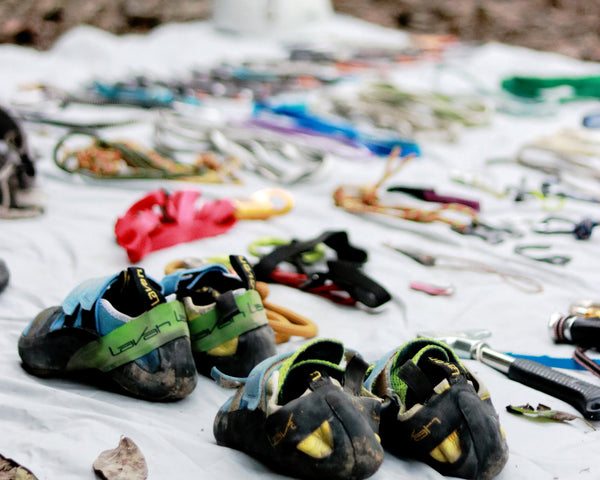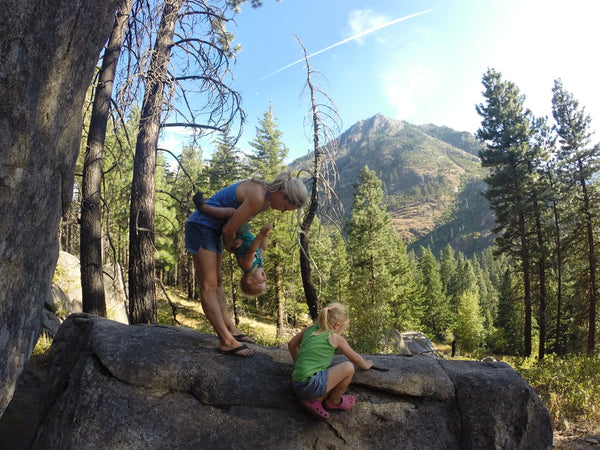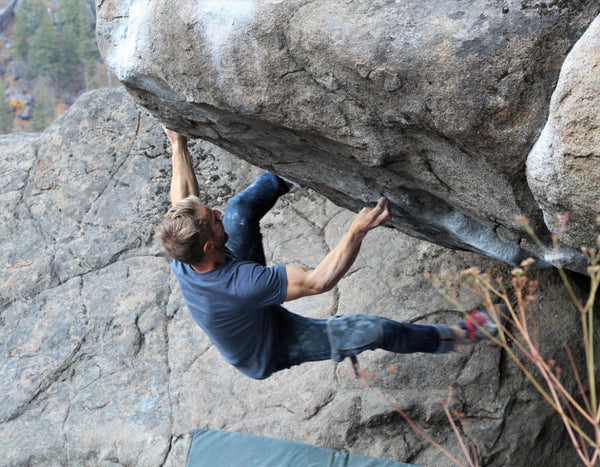6 ways to be more Sustainable | Keep nature green for generations to come

Here at Mountain Method, we love words that start with “S”: Stewardship, Sustainability, and Sending.
While most people associate mountain stewardship with activities like trail restoration, religious practice of Leave No Trace principles, and land preservation advocacy, the basic definition of stewardship is an “ethic that embodies the responsible planning and management of resources”, in fact applies to a much greater environmental awareness.
Crag and trail responsibility are only a small piece of the ‘Protect-our-Planet’ pie. They merely fit inside a larger framework of overall environmental awareness and greenhouse gas reduction (GHG). In other words, being a Mountain Steward is as much about sustainable living habits off the trail as it is on it.
If you’re not sure what we mean by “Mountain Steward” that’s okay - read this article to catch up. But if you clicked on this headline, we’ll assume you love nature, and that’s really all it comes down to: loving nature and caring enough to make small changes toward overall sustainability.

What to Expect
In this article, we talk about how simple ways to achieve sustainability and counter climate change outside direct mountain stewardship. Through these highly actionable and simple steps, it’s possible (and necessary) to protect the planet as a whole, rather than just your local parks and crags.
Keep reading for six sustainable living habits we can all start implementing TODAY.
- Learn the 5 R’s of zero waste.
Most people know the 3 R’s of Reduce, Reuse, Recycle. In practice, however, society confuses the 3 R’s into just one: Recycle, Recycle, Recycle. For years, people have been recycling like crazy
Turns out, recycling just isn’t enough. In fact, it’s actually an environmental hazard in its own right, since most plastic now gets shipped overseas to China for recycling, a process that creates more shipping emissions than the recycling avoids. Plus, of all the plastic people toss in the recycling bin, thinking they’re being an environmentally conscious person, only a disheartening 5% actually gets recycled.
Instead, let’s tack two more R’s on the phrase and move recycling down to the very bottom.
- Refuse things you don’t need, like single-use plastic and other disposable, low quality items
- Reduce things you do need, both in terms of resource and product consumption
- Reuse and repurpose things as much as possible, especially over buying new
- Rot, aka compost, anything organic
- Recycle anything that’s left
The 5 R’s are not a new concept, but they have most recently been brought into public consciousness by the zero waste movement. They are a hierarchy of how we should approach consumption and disposal of resources. For example, refusal (which is code for minimal consumption) should be the first resort and recycling the very last. If implemented universally, this system would ultimately eliminate waste.
There are tons of easy ways to implement the 5 R’s down right effortlessly into your daily routine. Pick a few especially simple ones to get started (like refusing plastic grocery bags) and add more as your get comfortable.
- Ride your bike.
Transportation accounts for a huge percentage of somewhat avoidable greenhouse gas emissions. According to the EPA, the average passenger vehicle emits about 404 grams of CO2 per mile driven. Even a close five-mile commute to and from work would then produce almost 2,500 pounds of CO2 in the year.
Instead of driving to work everyday, get up early a couple days to ride your bike. It’s great exercise. If your commute longer, organize a carpool with coworkers. All these options will not only prevent tons of CO2 emissions from, they’ll save you gas money (which you can put toward that National Parks road trip you’ve been dreaming of!).
- Take up Meatless Monday.
The meat industry is unsustainable. There, we said it. In fact, meat and dairy production is responsible for 50%+ of all agricultural greenhouse gas emissions and taking up 83% of all farmland. Beef in particular is responsible for over 2 times as much environmental impact as any other food category. It’s hardly surprising, since producing one pound of beef creates 25 pounds of CO2. Additionally, it takes 2,500 gallons of water to produce 1 pound of beef! To put this into perspective, each person in the US uses the same amount of water taking showers over a 6 month period.
That’s why Joseph Poore of the University of Oxford, claims adopting a “vegan diet is probably the single biggest way to reduce your impact on planet Earth.”
We’re not saying jump right in veganism, or even vegetarianism. Just moderating out meat consumption can make a huge impact. If the 32% of Americans that have heard of Meatless Monday took up the challenge for one year, that would mean the equivalent of taking 1.6 million cars from the road, according to the Center for a Livable Future.

- Shop and eat locally.
Shopping locally may be a little more expensive and less convenient, but who doesn’t want to support their local community? If you’re traveling to smaller communities close to national parks and outdoor recreation spots, it’s especially important to support small local businesses, because that money eventually makes its way back into supporting and protecting that location.
That’s the obvious benefit of shopping locally, but the less obvious benefits of reduced shipping emissions and supporting sustainable suppliers over multinational corporations are equally enticing.
So ditch the big box stores and buy your bread from your local bakery, without preservatives and without pollution.
- Implement water saving habits.
You’ve heard the saying, “If it’s yellow, let it mellow.” Surprise(!), it actually applies to more than just weak plumbing. The average toilet flush requires 3.6 gallons of water. By simply not flushing number one, we can save thousands of gallons of water per year.
There are tons of similar ways to save water that are basically an excuse for you to embrace your inner dirtbag (as if you need the excuse). Showering shorter and less often is good for the dirtbag soul and the planet. Doing laundry less often saves not only water but the life of your clothes (which then reduced textile waste in the long run).

- Become a conscious consumer.
This is perhaps the most important way to reduce your environmental footprint. As important as individual actions are, change needs to come from corporations, too. Every time we make a purchase, we cast a vote for the types of products we want companies to make. If we support poorly made and wasteful products, companies will keep providing them.
Thankfully, the outdoor gear industry has long been ahead of the pack, and brands have been stepping up in terms of sustainability (us here at Mountain Method included).
When it comes to choosing ethical outdoor brands, the OIA Sustainability Working Group is a fantastic resource, as is REI’s guide to choosing sustainable outdoor clothing and gear. To summarize, we should prioritize companies that prioritize things like animal welfare, Fair Trade factories, responsibly sourced natural fabrics or recycled synthetics (i.e. recycled rather than virgin polyester and nylon), and long product life spans by offering repair and recycling services.
These are the sustainable outdoor brands to support, even if it means paying a little bit more. Remember, lower prices just means corners were cut somewhere along the supply chain. Start scrutinizing your purchasing decisions. Ask yourself, “Why is this so cheap? Who, or what, is suffering for this steal?”
Nikki Hodgson of the Outdoor Industry Association (OIA) writes, “You don’t have to be stylish on the trail, but you do need to be responsible. You need to ensure that the gear you are using in our beloved outdoor spaces is not coming at the expense of them nor at the expense of people involved in sourcing and manufacturing that gear.”

Final Thoughts:
In another post on outdoor stewardship we wrote, “The lifeblood of being a Mountain Steward is developed, cultivated, and forged when we all take the time to slow down, be present, and protect the grandeur of nature.”
On a broader scale, sustainable living shares this same sentiment. It’s up to us as individuals to put in the effort to be mindful about how our everyday actions influence the world around us. When it comes down to it, volunteering to do trail maintenance every once in a while just isn’t enough to protect our wild spaces.
It’s the little changes that make the biggest environmental impact. We challenge you to assume responsibility every. single. Day. Start by:
Following the 5 R’s to be more conscious of how you consume and dispose of things.
- Ditching the drive to work every once in a while.
- Moderating how much meat (especially beef) you eat.
- Supporting small communities and shopping locally.
- Saving water for recreation, not running needlessly down the drain.
- Thinking before you buy.
Stewardship is a way of life that extends long beyond when we return from our adventures. Our ‘Mountain Method Culture’ is choosing to behave as consciously out of the mountains as much as we would in them - What’s yours?
Leave a comment
Comments will be approved before showing up.
Also in Mountain Method | Blog

FROM CADDY TO CRAG: 9 BOULDERING ESSENTIALS FOR MOUNTAIN STEWARDS
The Mountain Method Boulder Caddy enables you to “PACK less - SEND more!”, but that begs the question: what exactly should you pack?
Trad climbers are used to meticulously racking and re-racking their pro as a matter of life and death, but boulderers tend to be a far more Laissez-faire bunch. Beyond the obvious crash pad to protect our falls, however, are certain bouldering essentials to top off your cragging experience (so you can top out some boulders).
So, now that you have your crash pad and your Boulder Caddy, let’s talk about what to put in it.

Bouldering with Kids | The ultimate parent survival GUIDE



Amber McDaniel
Author